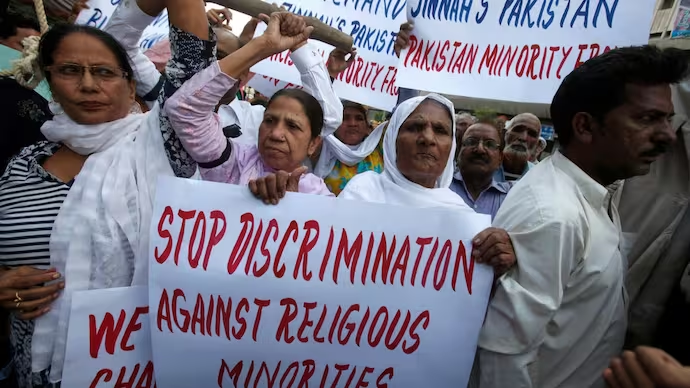Sectarian shadows: Shia marginalisation in Pakistan
- Snober Laharwal
- Aug 4, 2024
- 4 min read
On July 27, 2024, the Upper Kurram district in Pakistan's Khyber Pakhtunkhwa province was engulfed in violent clashes between two tribes, stemming from a long-standing land dispute. The conflict, centred in Boshera village, quickly escalated, resulting in the tragic loss of over 46 lives and injuries to 200 others. The conflict over a piece of land resulted in heavy clashes between two tribes, leading to the loss of at least 46 lives and injuries to more than 200 people over the course of some weeks. This district has a history of tribal, religious, and sectarian conflicts, as well as militant attacks. These violent clashes that started between the Maleekhel tribe, predominantly Shia, and the Madgi Kalay tribe, predominantly Sunni, over a disputed tract of land in Boshera village, located approximately 15 kilometres (9 miles) south of Parachinar city, in the Kurram district initially on the peace of land. The area is geographically closer to Kabul, Afghanistan's capital, than any major Pakistani city. It borders Afghanistan's Khost, Paktia, Logar, and Nangarhar provinces, which are known havens for anti-Shia armed groups such as ISIL (ISIS) and the Pakistani Taliban (TTP).

The marginalisation of Shia Muslims in Pakistan is a profound and enduring issue, rooted in complex historical, political, and socio-religious dynamics. This systematic exclusion has manifested through widespread discrimination, sectarian violence, and targeted attacks, profoundly affecting the Shia community's security and socio-economic status. The recent violent clashes in Pakistan's highlight the persistent and perilous nature of this marginalisation. Pakistan despite being a predominantly Muslim country, is home to a diverse range of religious communities, including Hindus, Christians, Bahá’i, Buddhists, Sikhs, and others. However, these minority groups face various forms of discrimination and persecution, which have intensified due to the rise of exclusionary nationalism favouring a narrow interpretation of Islam. Shia Muslims forms a major minority within the Muslim population. Despite being a recognised sect of Islam, Shia Muslims do not enjoy the same privileges and status as the Sunni majority.
The Shia community in Pakistan, which constitutes approximately 10-15% of the country's Muslim population, has long faced systemic marginalisation and persecution. Historically, this marginalisation is rooted in the sectarian schisms within Islam, exacerbated by the geopolitical landscape of the region. The rise of Sunni extremism, particularly since the late 1970s, has further intensified the sectarian divide. State policies and political manoeuvring have often pandered to radical Sunni elements, fostering an environment of intolerance and violence against Shias. Economically and socially, Shias have been disproportionately affected by discrimination, limiting their access to resources, employment, and educational opportunities. Sectarian biases have permeated various institutions, including law enforcement and the judiciary, resulting in inadequate protection and justice for Shia victims of violence. Politically, Shias have often been underrepresented and marginalized, with limited influence in decision-making processes that affect their community. The security situation for Shias in Pakistan has been dire, marked by frequent attacks on Shia processions, mosques, and community leaders. Extremist groups such as Lashkar-e-Jhangvi and Tehrik-i-Taliban Pakistan have explicitly targeted Shias, perpetuating a climate of fear and insecurity. These attacks have not only caused significant loss of life but have also contributed to the social and psychological trauma within the Shia Muslims.
The systemic discrimination against Shia Muslims has resulted in a climate of fear and insecurity for the community, hindering their ability to freely practice their faith and participate in society without the threat of violence. The small fight on land turned into a full scale fight between Sunnis and Shias of the province, resulting in significant loss of lives and injuries. These attacks serve as a stark reminder of the persistent sectarian tensions plaguing the region. The conflict in the province is just one example of the recurring violence faced by the Shia population in Pakistan. Sectarian clashes, militant attacks, and targeted killings have created an environment of fear and insecurity for Shias across the country. The failure of authorities to effectively address these issues has only exacerbated the situation, leaving the Shia community vulnerable and marginalized.
It is imperative for the Pakistani government to acknowledge and confront the systemic discrimination and violence faced by the Shia population. Concrete steps must be taken to ensure the protection of Shia citizens, hold perpetrators of violence accountable, and promote inter-sectarian harmony. Efforts to engage local communities, religious leaders, and law enforcement agencies in dialogue and conflict resolution are crucial in addressing the root causes of sectarian strife. International pressure and advocacy can play a significant role in urging the Pakistani authorities to prioritize the protection of minority communities, including the Shia population. The international community must speak out against religious persecution and work towards supporting initiatives that promote tolerance, inclusivity, and respect for religious diversity in Pakistan.
The ongoing persecution of Shias in Pakistan demands sustained attention and concerted action from both domestic and international stakeholders. By addressing the challenges faced by the Shia community and upholding the principles of religious freedom and human rights, Pakistan can move towards building a society that is inclusive, just, and free from sectarian violence.
(Author is PhD student at Jamia Millia Islamia, New Delhi and a member of International Writers Association, USA).








Comments